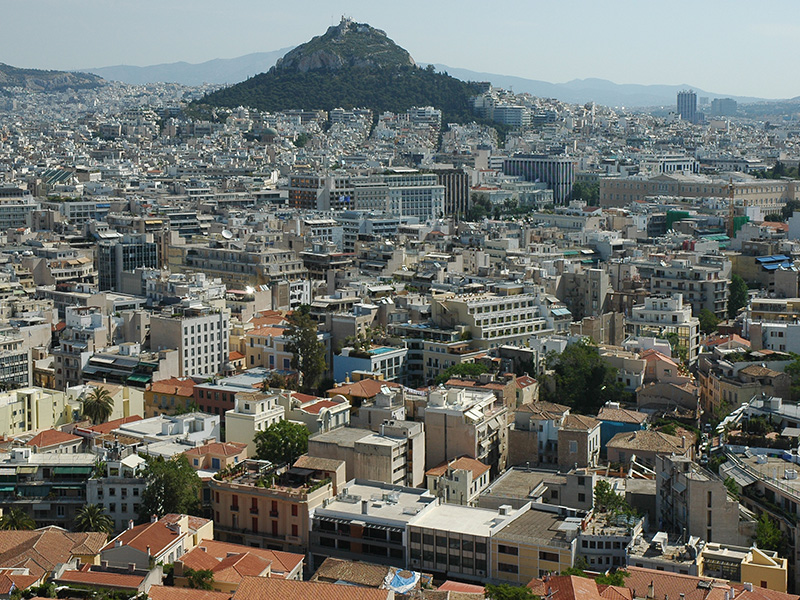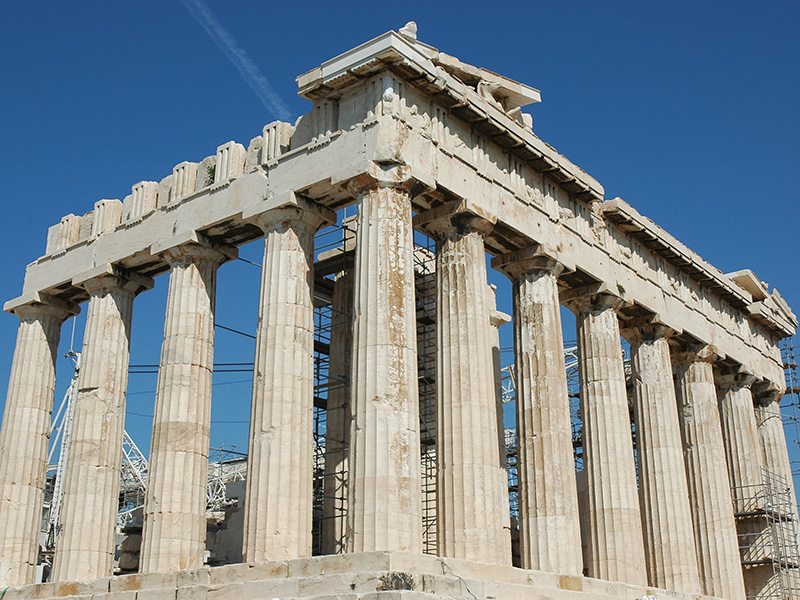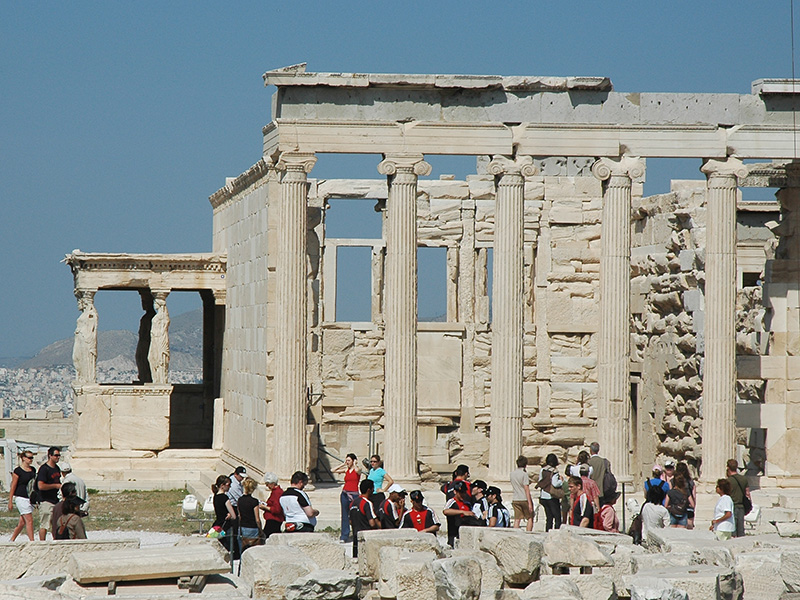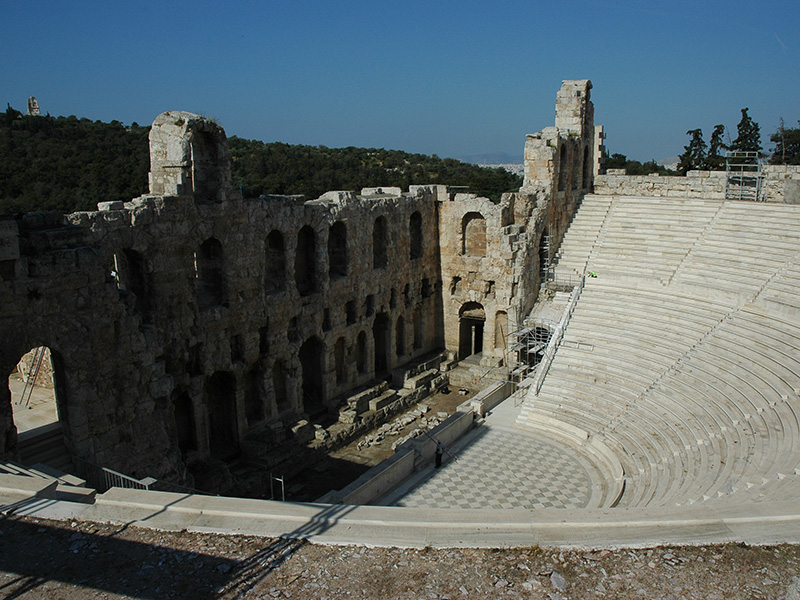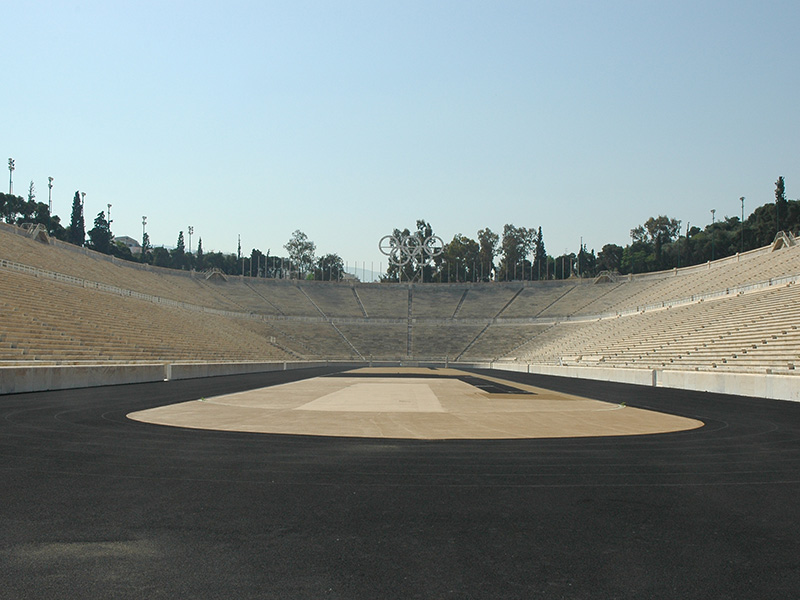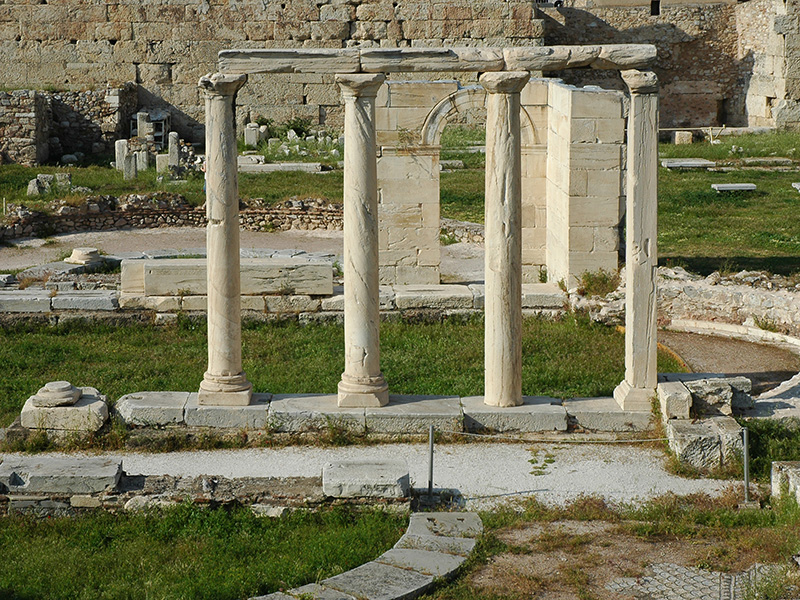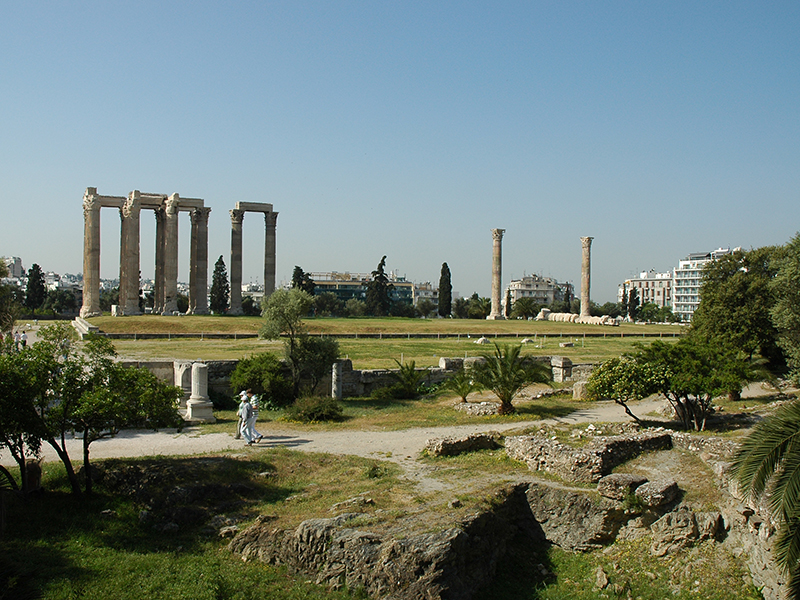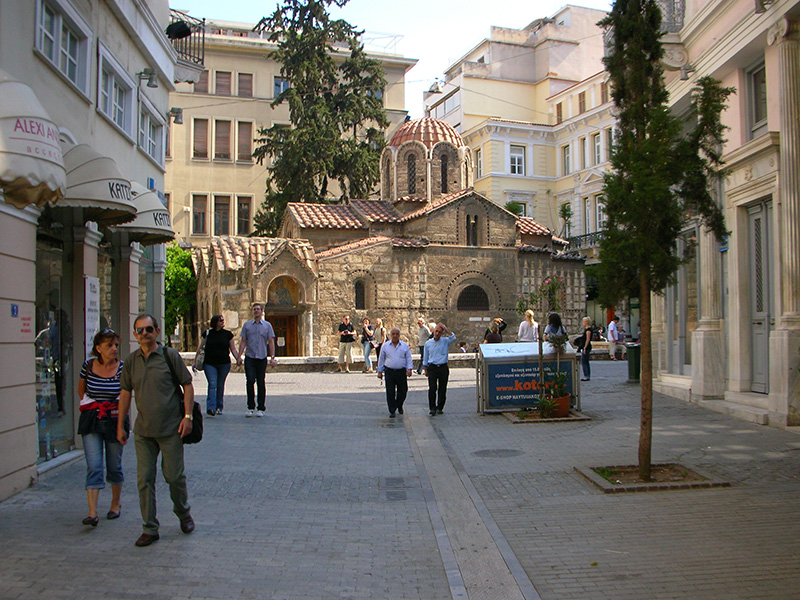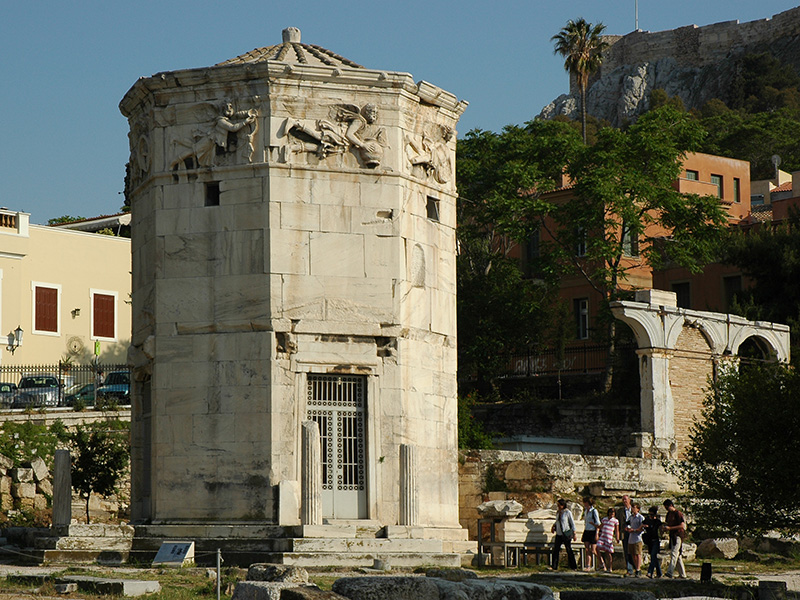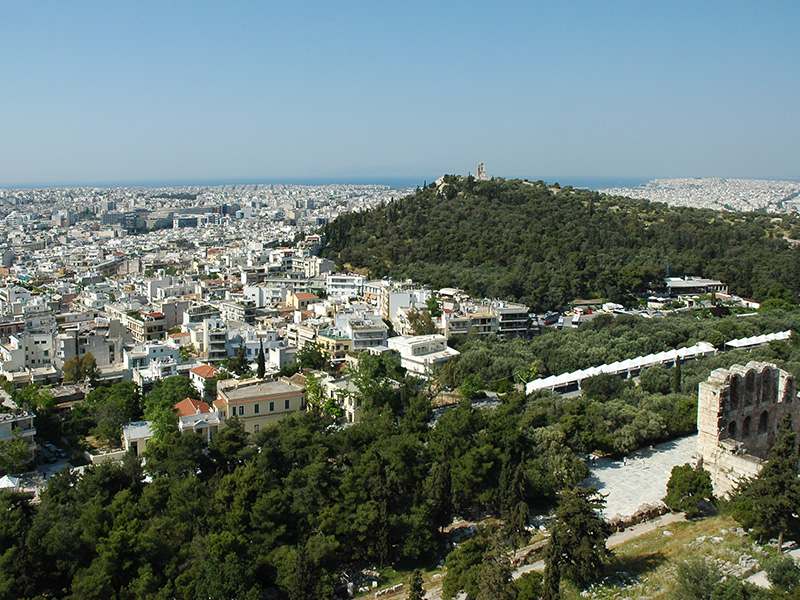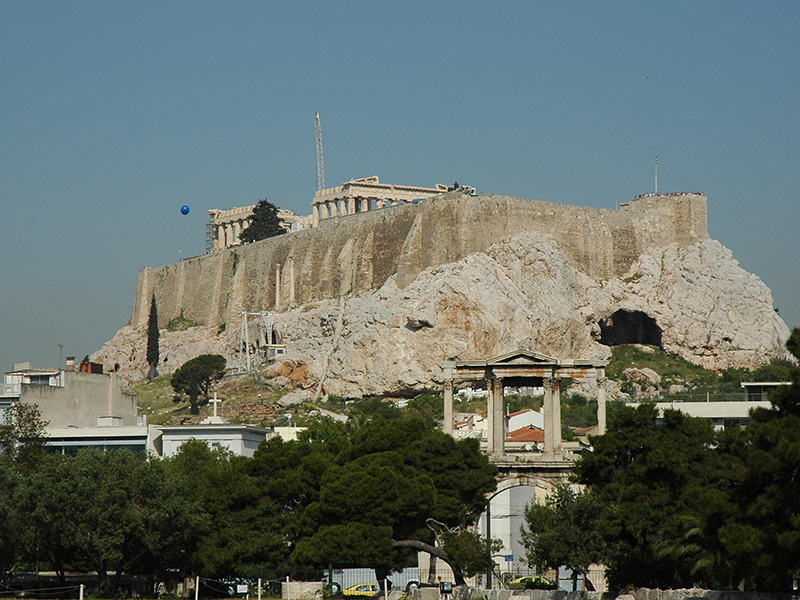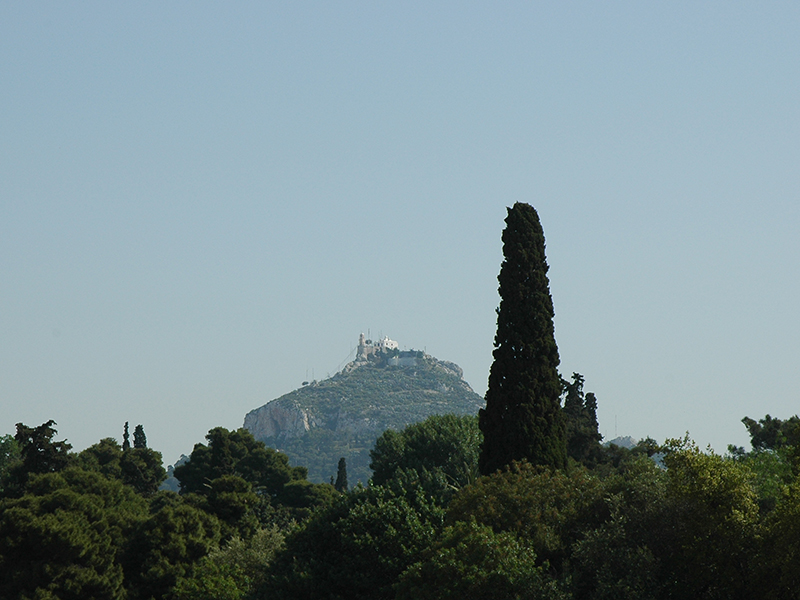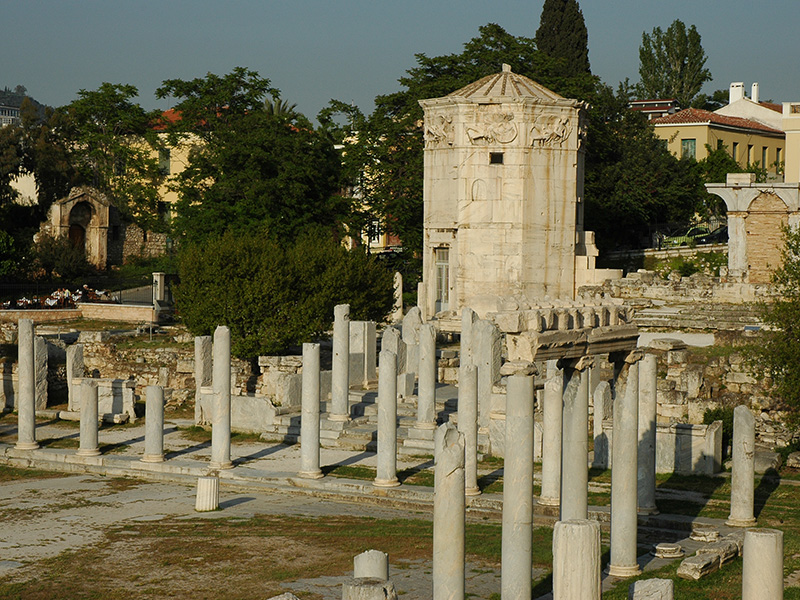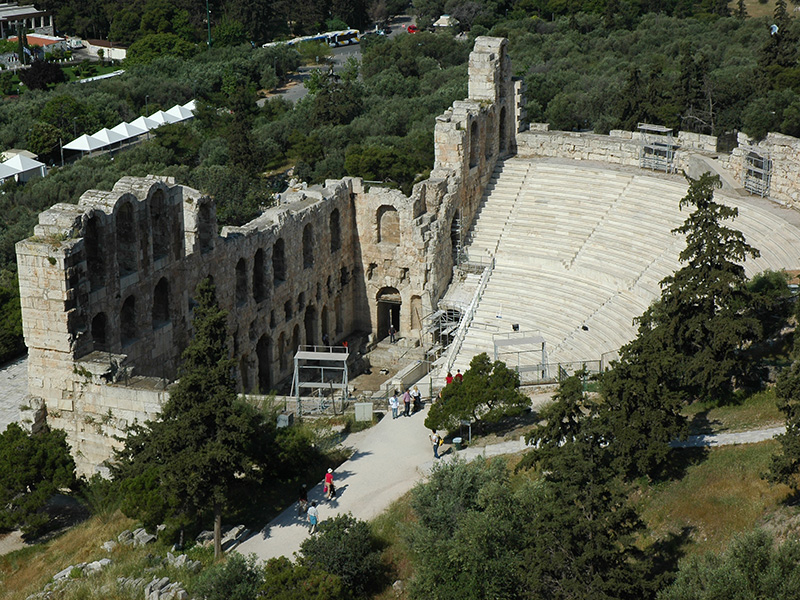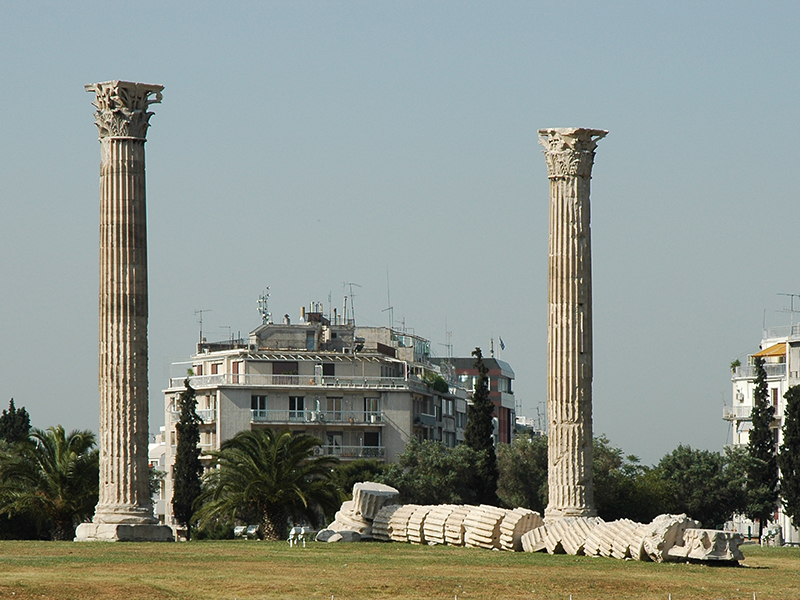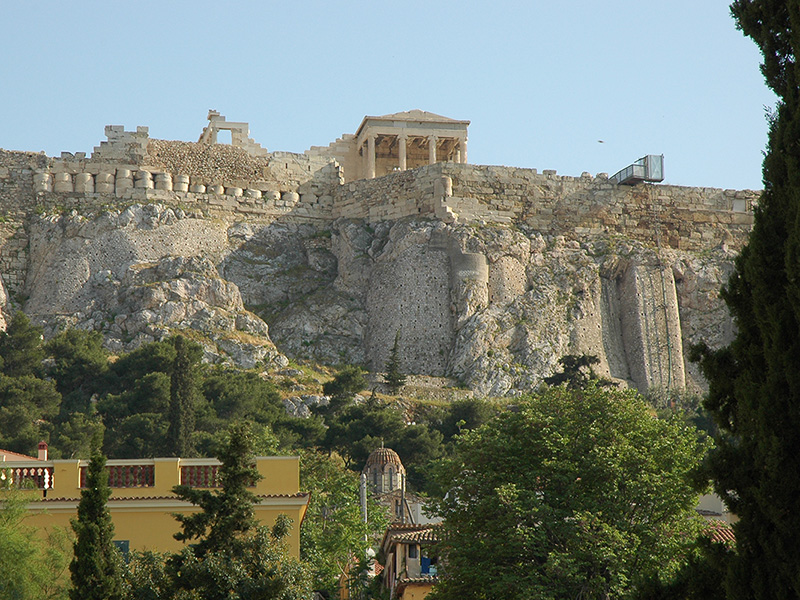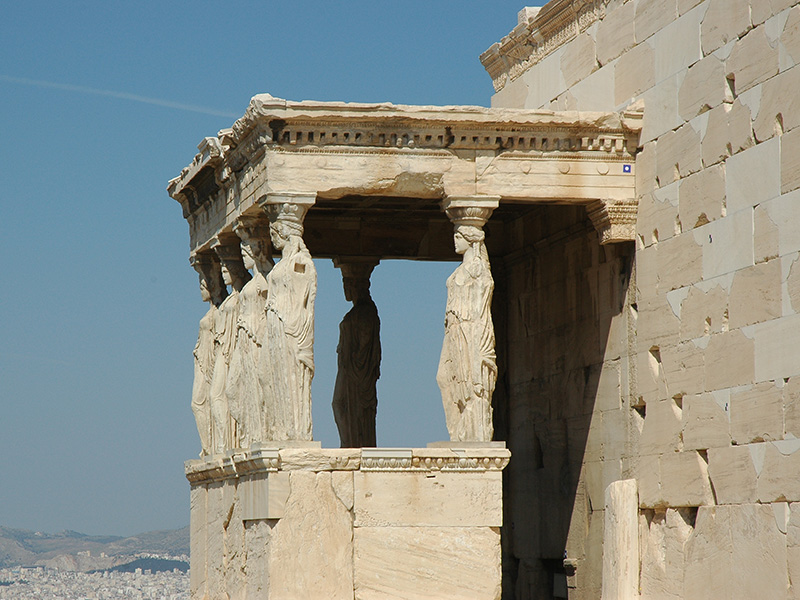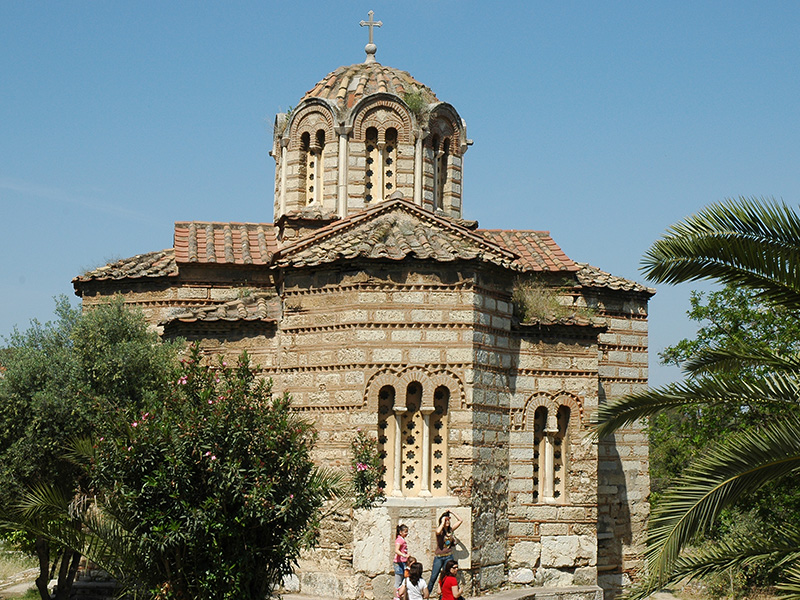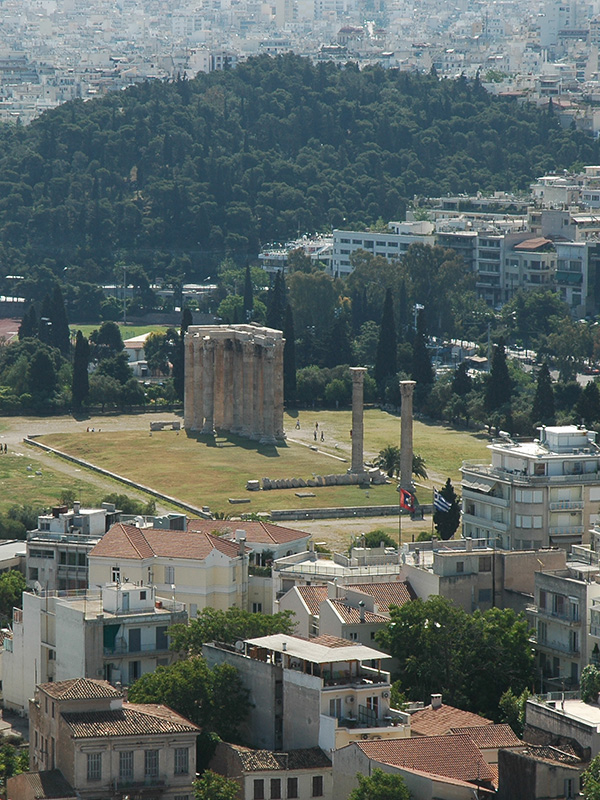Photo gallery
The area where today's Athens is located has been inhabited since prehistoric times. The nucleus of the city of Athens was a fortress, built on a hill (today known as the Acropolis of Athens) in the Mycenaean period in the middle of the second millennium BC, later transformed into a place of worship, surrounded by a city expanding on the neighboring hills. In 480 BC Athens was destroyed by the Persians, but soon after the city was rebuilt and fortified, entering in the second half of the 5th century BC into a period of prosperity, lasting until the loss of independence in 338 BC, when all of Greece at that time was subordinated to Macedonia. Later, under the reign of Rome, then the Byzantine Empire, and especially after 1458, when the former Greece was in the hands of the Ottoman Empire, Athens lost its importance. They regained it only in the 19th century, when after the victorious war of independence and the establishment of the Kingdom of Greece, the city (then having several thousand inhabitants, several dozen times less than in the classical period) was chosen as the capital of the reborn state, mainly due to its historical significance.
Athens is located in the region of Attica, an area that stretches between the gulf of the Aegean Sea known as the Saronic Gulf [Σαρωνικός κόλπος]
 and four mountains: Egaleo
and four mountains: Egaleo  [Αιγάλεω] (469 m), Parnita [Πάρνηθα]
[Αιγάλεω] (469 m), Parnita [Πάρνηθα]  ( 1413 m), Hymet
( 1413 m), Hymet  [Υμηττός] (1026 m) and Penteleikon
[Υμηττός] (1026 m) and Penteleikon  [Πεντέλη, Πεντελικόν or Πεντελικό Όρος] (1109 m).
[Πεντέλη, Πεντελικόν or Πεντελικό Όρος] (1109 m).
 stands for Piraeus [Πειραιάς], one of the largest ports of the Mediterranean, belonging to Athens in the classical period, today functioning as a separate city, but forming one urban organism with Athens.
stands for Piraeus [Πειραιάς], one of the largest ports of the Mediterranean, belonging to Athens in the classical period, today functioning as a separate city, but forming one urban organism with Athens. [Λυκαβηττός] (the name "Lycabettus" is also often used in the literature), with the chapel of St. George (Agios Georgios) from the 19th century, an amphitheater where various events are organized, a restaurant, a café and a terrace with a vast, spectacular view of Athens and its surroundings. You can climb to the top (leaving your car in one of the car parks at the foot of the hill) or take the cable car, whose lower station
[Λυκαβηττός] (the name "Lycabettus" is also often used in the literature), with the chapel of St. George (Agios Georgios) from the 19th century, an amphitheater where various events are organized, a restaurant, a café and a terrace with a vast, spectacular view of Athens and its surroundings. You can climb to the top (leaving your car in one of the car parks at the foot of the hill) or take the cable car, whose lower station  is located on the southern slopes the hill of the affluent and one of the most famous commercial districts of Athens, Kolonaki
is located on the southern slopes the hill of the affluent and one of the most famous commercial districts of Athens, Kolonaki  [Κολωνάκι].
[Κολωνάκι].The most interesting touristic areas of Athens and the most important monuments of the city lie to the west of Lycavitos Hill, on both sides of the axis connecting the two important squares of Athens, Sintagma Square
 [Πλατεία Συντάγματος], and Omonia Square
[Πλατεία Συντάγματος], and Omonia Square  [Πλατεία Ομονοίας]. These include, in particular, the Acropolis of Athens
[Πλατεία Ομονοίας]. These include, in particular, the Acropolis of Athens  [Ακρόπολη Αθηνών], an ancient citadel on a hill with numerous buildings of particular architectural value and historical importance (such such as the Parthenon [Παρθενών], the Erechtheion [Ερέχθειο] or the Propylaea [Προπύλαια]) and the nearby buildings of the Odeon of Herodes Atticus [Ωδείο Ηρώδου του Αττικού Αττικού] and Dizosa Theatre; about monuments in the area of the Acropolis, see below (Acropolis). The
[Ακρόπολη Αθηνών], an ancient citadel on a hill with numerous buildings of particular architectural value and historical importance (such such as the Parthenon [Παρθενών], the Erechtheion [Ερέχθειο] or the Propylaea [Προπύλαια]) and the nearby buildings of the Odeon of Herodes Atticus [Ωδείο Ηρώδου του Αττικού Αττικού] and Dizosa Theatre; about monuments in the area of the Acropolis, see below (Acropolis). The  marker stands for the former Athenian agora, with a well-preserved temple known as Hephaestion [Ναός Ηφαίστου], reconstructed so-called the stoa of Attalos, as well as the Church of the Holy Apostles erected in the agora in the 10th century; about monuments in the region of the Greek Agora, see below (Agora). The marker
marker stands for the former Athenian agora, with a well-preserved temple known as Hephaestion [Ναός Ηφαίστου], reconstructed so-called the stoa of Attalos, as well as the Church of the Holy Apostles erected in the agora in the 10th century; about monuments in the region of the Greek Agora, see below (Agora). The marker  means the Roman Forum, which is an extension of the Greek agora to the east, e.g. from the so-called the Tower of the Winds, the remains of Hadrian's library and the Fethiye Tzami mosque, erected on this site in the 17th century; about the area of the Forum, see below (Forum).
means the Roman Forum, which is an extension of the Greek agora to the east, e.g. from the so-called the Tower of the Winds, the remains of Hadrian's library and the Fethiye Tzami mosque, erected on this site in the 17th century; about the area of the Forum, see below (Forum). , today the seat of the Greek Parliament; further south, the National Gardens stretch
, today the seat of the Greek Parliament; further south, the National Gardens stretch  [Εθνικός Κήπος], today a public park. Near its southwestern end are the remains of the temple of Olympian Zeus
[Εθνικός Κήπος], today a public park. Near its southwestern end are the remains of the temple of Olympian Zeus  [Ναός του Ολυμπίου Διός], the largest temple in ancient Greece, and near the south-east - the restored Panathena Stadium
[Ναός του Ολυμπίου Διός], the largest temple in ancient Greece, and near the south-east - the restored Panathena Stadium  [Παναθηναϊκό Στάδιο, also Καλιμάρμαρο], the scene of the first Olympic Games of the modern era, organized in 1896. In the vicinity of Syntagma Square, the most important Athenian scientific institutions and several museums are located, as well as the most important churches; marker
[Παναθηναϊκό Στάδιο, also Καλιμάρμαρο], the scene of the first Olympic Games of the modern era, organized in 1896. In the vicinity of Syntagma Square, the most important Athenian scientific institutions and several museums are located, as well as the most important churches; marker  means the historical district of Plaka [Πλάκα], which is one of the most popular tourist areas of the city. For monuments and tourist attractions in the Syntagma Square area, see below (Sintagma).
means the historical district of Plaka [Πλάκα], which is one of the most popular tourist areas of the city. For monuments and tourist attractions in the Syntagma Square area, see below (Sintagma).Marker
 stands for for Omonia square, and marker
stands for for Omonia square, and marker  - for Exarcheia district [Εξάρχεια], considered a dangerous district, inhabited by the poor, anarchists, leftists and anarchists, in which, however, the most important and famous museum of Athens is located, the National Archaeological Museum
- for Exarcheia district [Εξάρχεια], considered a dangerous district, inhabited by the poor, anarchists, leftists and anarchists, in which, however, the most important and famous museum of Athens is located, the National Archaeological Museum  [Εθνικό Αρχαιολογικό Μουσείο], the largest in Athens and one of the most important archaeological museums in the world. South-west of Omonia Square and north-west of the ancient agora area, lies the district of Kerameikos, with another notable archaeological museum. For monuments and tourist attractions in the area of Omonia Square, see below (Omonia).
[Εθνικό Αρχαιολογικό Μουσείο], the largest in Athens and one of the most important archaeological museums in the world. South-west of Omonia Square and north-west of the ancient agora area, lies the district of Kerameikos, with another notable archaeological museum. For monuments and tourist attractions in the area of Omonia Square, see below (Omonia).Acropolis
Acropolis of Athens  - it's 157 m above sea level high limestone hill, already playing the role of a citadel in Mycenaean times. Later, the hill became a place of worship, and its surroundings began to be developed with buildings for various purposes, which have not survived to our times. What constitutes today's buildings of the Acropolis are the remains of buildings erected in the 5th century BC, when the Acropolis was rebuilt, on the initiative of Pericles (495-429), after the destruction of Athens by the Persians, and existing (in better or worse condition) until 1687, when during the siege of Athens (then belonging to the Ottoman Empire) by the Venetians, the explosion of a gunpowder tank hit by a Venetian bullet destroyed most of the hill's buildings.
- it's 157 m above sea level high limestone hill, already playing the role of a citadel in Mycenaean times. Later, the hill became a place of worship, and its surroundings began to be developed with buildings for various purposes, which have not survived to our times. What constitutes today's buildings of the Acropolis are the remains of buildings erected in the 5th century BC, when the Acropolis was rebuilt, on the initiative of Pericles (495-429), after the destruction of Athens by the Persians, and existing (in better or worse condition) until 1687, when during the siege of Athens (then belonging to the Ottoman Empire) by the Venetians, the explosion of a gunpowder tank hit by a Venetian bullet destroyed most of the hill's buildings. , Echechtheum
, Echechtheum  , Propylaea
, Propylaea  and Temple of Athena-Nike
and Temple of Athena-Nike  .
.The Parthenon, one of the most important monuments of Athens, a former temple dedicated to Athena Parthenos, stands in the center of the Acropolis, on the site of a previously existing temple, destroyed in 480 BC. by the Persians. The temple was built of white Pentelic marble in the mid-5th century BC. under the supervision of Phidias, who was also supposed to be the creator of the sculptural decoration, including the author of a huge, 12-meter statue of the goddess constituting the central place of the temple and considered one of the most important works of Phidias, not preserved to our times. The building, surrounded by a colonnade of 46 columns, is considered one of the most outstanding examples of a temple erected in the Doric order. Destroyed by fire at the end of the Roman period, rebuilt in the 4th century, in the next century it was rebuilt, deprived of some of the sculptures and transformed into a Christian church, later, after the capture of Athens by the Turks, it was transformed into a mosque. In 1687 it was seriously damaged by the aforementioned powder tank explosion. At the beginning of the 19th century, part of the preserved sculptural decoration, known as the so-called the Elgin Marbles, was (with the consent of the Turkish authorities) exported and sold to the British government (today the "Elgin Marbles" are exhibited in the British Museum in London); another part of the sculptural decoration formerly adorning the Parthenon can be seen in the Louvre in Paris.
Erechtheion - is a four-level temple dedicated to Poseidon and Athena, built in honor of Erechtheus, in Greek mythology the hero and king of Athens (hence the name). The first temple on this site was destroyed, as was the temple on which the Parthenon stands, in 480 by the Persians; it was rebuilt as a Prolosus in the Ionic order in the last two decades of the 5th century BC and is considered the pinnacle of Ionic architecture in the Attica region. In the 6th century AD the Erechtheion was converted into a church, and during the period of Turkish rule it was used as a harem for some time. Later, in the 17th century, it fell into disrepair, and in the first decade of the 20th century it was reconstructed. In 1979, the renovation of the building began, which continues to this day.
The construction of the Propylaea, a marble gatehouse in the Doric style, which is the entrance to the Athenian Acropolis from the west, began in 437 BC, was interrupted after a few years and never completed - despite this, the building is considered the most famous propylaea in the world and has become a model for many other buildings of the same period in antiquity, as well as neoclassical buildings in our times, such as the Propylaea standing in the middle of the square known as Königsplatz in Munich. Near the Propylaea, in the south-western part of the Acropolis, there is a small temple of Athena Nike in the Ionian style, demolished in 1686 by the Turks, reconstructed after Greece regained its independence.
The Akropolis complex also includes the Odeon of Herod Atticus
 , the largest and considered the greatest of the ancient odeons, built on the south-western slope of the Acropolis in the 2nd century CE. , known for its excellent acoustics and being one of the stages where cultural events take place as part of the Athens Festival, as well as the Theater of Dionysus
, the largest and considered the greatest of the ancient odeons, built on the south-western slope of the Acropolis in the 2nd century CE. , known for its excellent acoustics and being one of the stages where cultural events take place as part of the Athens Festival, as well as the Theater of Dionysus  located on the southern slope Acropolis, with a history dating back to the 6th century BC, built in the shape partially preserved to this day in the 4th century BC. and a model for many other Greek theaters built later.
located on the southern slope Acropolis, with a history dating back to the 6th century BC, built in the shape partially preserved to this day in the 4th century BC. and a model for many other Greek theaters built later.The marker
 means the hill of Ares, the meeting place of Aeropag, the marker
means the hill of Ares, the meeting place of Aeropag, the marker  - Filopappos Hill, a good vantage point (especially for the Acropolis and the Odeon of Herod Atticus), and the
- Filopappos Hill, a good vantage point (especially for the Acropolis and the Odeon of Herod Atticus), and the  marker - the new Acropolis Museum opened in 2009 , one of the most visited Athens museums.
marker - the new Acropolis Museum opened in 2009 , one of the most visited Athens museums.Greek Agora
The second area of Athens important from the tourist point of view is the complex of public buildings of the ancient Athenian agora  , located northwest of the Acropolis, almost entirely destroyed over the centuries and replaced by chaotic urban buildings, demolished (thanks to which archaeological work could begin) only in the 1960s.
, located northwest of the Acropolis, almost entirely destroyed over the centuries and replaced by chaotic urban buildings, demolished (thanks to which archaeological work could begin) only in the 1960s. , a temple dedicated to Hephaestus and Athena, erected in the Doric order in the second half of the 5th century BC. In the 5th century AD the building was converted into a christian church that survived the period of turkish rule, although there were plans to demolish it for building materials. Soon after the independence of greece it was declared a national monument and today it is considered one of the best preserved monuments of ancient greek architecture.
, a temple dedicated to Hephaestus and Athena, erected in the Doric order in the second half of the 5th century BC. In the 5th century AD the building was converted into a christian church that survived the period of turkish rule, although there were plans to demolish it for building materials. Soon after the independence of greece it was declared a national monument and today it is considered one of the best preserved monuments of ancient greek architecture.The marker
 stands fpr the so-called the stoa of Attalos, completely reconstructed in the 1950s. Near the Agora Museum stands a small church of the Holy Apostles, famous for its Byzantine frescoes
stands fpr the so-called the stoa of Attalos, completely reconstructed in the 1950s. Near the Agora Museum stands a small church of the Holy Apostles, famous for its Byzantine frescoes  [Άγιοι Απόστολοι Σολάκη], probably built in the second half of the 10th century and restored to a less more of the original character in the 1950s.
[Άγιοι Απόστολοι Σολάκη], probably built in the second half of the 10th century and restored to a less more of the original character in the 1950s.Roman Forum
An extension of the ancient Greek agora is the Roman Forum  , marked out near the northern slope of the Acropolis, about 150 m east of the agora as a rectangular square measuring 98 x 111 meters, put into use during the reign of Octavian Augustus.
, marked out near the northern slope of the Acropolis, about 150 m east of the agora as a rectangular square measuring 98 x 111 meters, put into use during the reign of Octavian Augustus. , one of the best-preserved buildings of ancient Athens, Roman marble clock tower, 6th century AD transformed into a Christian chapel, and during the Turkish rule into the seat of the Sufi order, and remains of the library
, one of the best-preserved buildings of ancient Athens, Roman marble clock tower, 6th century AD transformed into a Christian chapel, and during the Turkish rule into the seat of the Sufi order, and remains of the library  founded by Emperor Hadrian in the 2nd century CE, destroyed in warfare in the 3rd century AD, but later rebuilt and expanded.
founded by Emperor Hadrian in the 2nd century CE, destroyed in warfare in the 3rd century AD, but later rebuilt and expanded.Marker
 means built in the years 1668-1670 by the Turks, the so-called The Mosque of the Conquerors, Fethiye Tzami [Φετιχιέ τζαμί], converted into a Catholic church during the brief occupation of Athens by the Venetian army in 1687-1688. After Greece regained its independence, the mosque became secularized and served various functions; after a long period of restoration work, it was opened to the public in 2017 as an institution organizing various types of cultural events.
means built in the years 1668-1670 by the Turks, the so-called The Mosque of the Conquerors, Fethiye Tzami [Φετιχιέ τζαμί], converted into a Catholic church during the brief occupation of Athens by the Venetian army in 1687-1688. After Greece regained its independence, the mosque became secularized and served various functions; after a long period of restoration work, it was opened to the public in 2017 as an institution organizing various types of cultural events.Sintagma Square, National Gardens and surroundings
As mentioned above, Sintagma Square  - is probably the most important square in Athens. At the square there is one of the most important public buildings of Athens, marked with
- is probably the most important square in Athens. At the square there is one of the most important public buildings of Athens, marked with  former royal palace, built in 1836-1843, today the seat of the Greek Parliament . At the end of the 1840s, the construction of the Royal Gardens
former royal palace, built in 1836-1843, today the seat of the Greek Parliament . At the end of the 1840s, the construction of the Royal Gardens  (today known as the National Gardens [Εθνικός Κήπος surrounding the building from the east and south began.
(today known as the National Gardens [Εθνικός Κήπος surrounding the building from the east and south began. stands for a building known as the Zappeion [Ζάππειο], built in 1874-1888 according to the design of Theophil Hansen on the initiative of the Greek patriot and philanthropist, Evangelist Zappas . The building was used during the 1896 Olympics (and later) as a sports facility; today it houses the Exhibition and Congress Centre.
stands for a building known as the Zappeion [Ζάππειο], built in 1874-1888 according to the design of Theophil Hansen on the initiative of the Greek patriot and philanthropist, Evangelist Zappas . The building was used during the 1896 Olympics (and later) as a sports facility; today it houses the Exhibition and Congress Centre.Near the south-western corner of the National Gardens, there are two important monuments, the history of which dates back to Antiquity: one of them is the Temple of Olympian Zeus
 , the other - the arch Hadrian
, the other - the arch Hadrian  . The construction of the temple, the largest of the temples of ancient Greece, began in the 6th century BC and was completed in the 2nd century BC, during the reign of Hadrian. Starting from the Middle Ages, the temple was treated as a source of building material and was eventually almost completely destroyed (only a dozen or so columns have survived). Hadrian's Arch was also built during Hadrian's reign as part of a city expansion project.
. The construction of the temple, the largest of the temples of ancient Greece, began in the 6th century BC and was completed in the 2nd century BC, during the reign of Hadrian. Starting from the Middle Ages, the temple was treated as a source of building material and was eventually almost completely destroyed (only a dozen or so columns have survived). Hadrian's Arch was also built during Hadrian's reign as part of a city expansion project.Near the south-eastern corner of the National Gardens, there is the Panathena Stadium
 , originally built in a natural hollow of land, by the river, in the 4th century BC. Rebuilt in the 2nd century BC it was found during excavations in 1870. The stadium, reconstructed for the Olympic Games in 1896, is today used as a stage for various cultural events.
, originally built in a natural hollow of land, by the river, in the 4th century BC. Rebuilt in the 2nd century BC it was found during excavations in 1870. The stadium, reconstructed for the Olympic Games in 1896, is today used as a stage for various cultural events. [Καθεδρικός Ιερός Ναός Ευαγγελισμού της Θεοτόκου], a three-nave basilica with a dome and two towers, the main temple of the Greek Orthodox Church, the seat of the Archbishop of Athens and all Greece, erected in the years 1842-1863, church of Panagia Gorgoepikoos
[Καθεδρικός Ιερός Ναός Ευαγγελισμού της Θεοτόκου], a three-nave basilica with a dome and two towers, the main temple of the Greek Orthodox Church, the seat of the Archbishop of Athens and all Greece, erected in the years 1842-1863, church of Panagia Gorgoepikoos  [Παναγία Γοργοεπήκοος], also known as Agios Eleftherios [Άγιος Ελευθέριος], built between the 9th and 13th century, with Romanesque and Byzantine influences, and the church of Panagia Kapnikarea
[Παναγία Γοργοεπήκοος], also known as Agios Eleftherios [Άγιος Ελευθέριος], built between the 9th and 13th century, with Romanesque and Byzantine influences, and the church of Panagia Kapnikarea  [Παναγίας Καπνικαρέας], one of the oldest Byzantine churches in Athens, probably from the 11th century, built on the ruins of an earlier ancient temple.
[Παναγίας Καπνικαρέας], one of the oldest Byzantine churches in Athens, probably from the 11th century, built on the ruins of an earlier ancient temple. [Βυζαντινό και Χριστιανικό Μουσείο], Benakis Museum
[Βυζαντινό και Χριστιανικό Μουσείο], Benakis Museum  [Μουσείο Μπενάκη] and Museum of Cycladic and Ancient Art
[Μουσείο Μπενάκη] and Museum of Cycladic and Ancient Art [Μουσείο Κυκλαδικής Τέχνης]. The first, founded in 1914, is one of the world's most important museums dedicated to Byzantine art. The Benakis Museum exhibits a once-private Benakis family collection of ancient, Byzantine and Oriental art. The third of these museums, founded in 1986, presents a collection of Cycladic art (including works from the Bronze Age), once owned by Nicholas and Dolly Goulandris; the museum also organizes temporary exhibitions by prominent Greek and foreign artists.
[Μουσείο Κυκλαδικής Τέχνης]. The first, founded in 1914, is one of the world's most important museums dedicated to Byzantine art. The Benakis Museum exhibits a once-private Benakis family collection of ancient, Byzantine and Oriental art. The third of these museums, founded in 1986, presents a collection of Cycladic art (including works from the Bronze Age), once owned by Nicholas and Dolly Goulandris; the museum also organizes temporary exhibitions by prominent Greek and foreign artists. [Νομισματικό Μουσείο], housed in a house that once belonged to the famous archaeologist Heinrich Schliemann, which has one of the world's largest collections of ancient and modern coins. Further north stand three 19th-century Neoclassical buildings designed by Theofil Hansen, housing the three most important institutions of learning in Athens: the building of the Academy of Athens
[Νομισματικό Μουσείο], housed in a house that once belonged to the famous archaeologist Heinrich Schliemann, which has one of the world's largest collections of ancient and modern coins. Further north stand three 19th-century Neoclassical buildings designed by Theofil Hansen, housing the three most important institutions of learning in Athens: the building of the Academy of Athens  , founded in 1926 and referring to the ancient Academy of Plato, the historic building of the University
, founded in 1926 and referring to the ancient Academy of Plato, the historic building of the University  , today housing the rectorate of the university and used for representative purposes, and founded in 1824 the building of the National Library
, today housing the rectorate of the university and used for representative purposes, and founded in 1824 the building of the National Library  , which has one of the largest collections of Greek manuscripts in the world.
Also in this area is the Catholic Cathedral of Dionysius the Areopagite
, which has one of the largest collections of Greek manuscripts in the world.
Also in this area is the Catholic Cathedral of Dionysius the Areopagite  , the main Roman Catholic church in Greece and the seat of the Catholic Archbishop of Athens.
, the main Roman Catholic church in Greece and the seat of the Catholic Archbishop of Athens.Omonia Square and its surroundings
Omonia Square  [Πλατεία Ομονοίας] is one of the oldest squares of today's Athens, laid out in 1846, for some time not enjoying a good reputation (pickpockets, drugs, the homeless, prostitution).
[Πλατεία Ομονοίας] is one of the oldest squares of today's Athens, laid out in 1846, for some time not enjoying a good reputation (pickpockets, drugs, the homeless, prostitution). (also considered rather dangerous), is the National Archaeological Museum
(also considered rather dangerous), is the National Archaeological Museum  [Εθνικό Αρχαιολογικό Μουσείο], one of the most important museums in the world, with an extremely rich collection of exhibits from prehistoric times to late antiquity. The nucleus of the Athens National Archaeological Museum was a museum founded on the island of Aegina in 1829 by the then Prime Minister of Greece, Joanis Kapodistrias; later, for some time, the collected collection was exhibited in various exhibition halls. The current seat of the museum was built between 1866 and 1889; since 1881, the museum, initially known as the Central Museum, bears its current name.
[Εθνικό Αρχαιολογικό Μουσείο], one of the most important museums in the world, with an extremely rich collection of exhibits from prehistoric times to late antiquity. The nucleus of the Athens National Archaeological Museum was a museum founded on the island of Aegina in 1829 by the then Prime Minister of Greece, Joanis Kapodistrias; later, for some time, the collected collection was exhibited in various exhibition halls. The current seat of the museum was built between 1866 and 1889; since 1881, the museum, initially known as the Central Museum, bears its current name.South-west of Omonia Square lies Keramejkos
 , a historical district inhabited in the Antiquity by artisans making ceramic articles (κεραμικός - hence the name of the district). In the district, there is the Kermaikos Archaeological Museum
, a historical district inhabited in the Antiquity by artisans making ceramic articles (κεραμικός - hence the name of the district). In the district, there is the Kermaikos Archaeological Museum  .
.